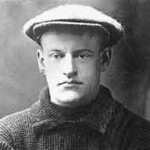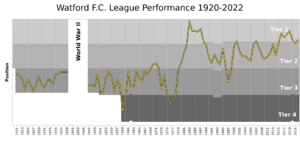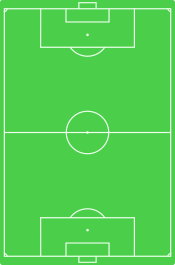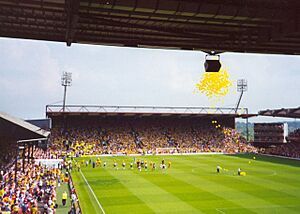Watford F.C. facts for kids
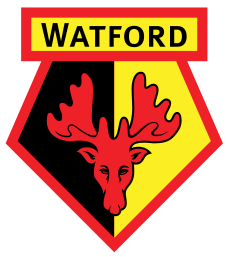 |
||||
| Full name | Watford Football Club | |||
|---|---|---|---|---|
| Nickname(s) |
|
|||
| Founded | 1881 | |||
| Ground | Vicarage Road | |||
| Capacity | 22,200 | |||
| Owner | Gino Pozzo | |||
| Chairman | Scott Duxbury | |||
| Manager | Paulo Pezzolano | |||
| League | Premier League | |||
| 2018–19 | Premier League, 11th of 20 | |||
|
||||
Watford Football Club is a professional football team from Watford, Hertfordshire, England. They are known as "The Hornets" and play in the EFL Championship, which is the second highest league in English football.
The team has played at their home stadium, Vicarage Road, since 1922. Before that, they used several other grounds. Watford has a long-standing friendly competition with their nearby rivals, Luton Town.
A famous manager named Graham Taylor helped Watford climb from the fourth division to the top league between 1977 and 1987. They finished second in the top league in 1983 and even played in a European competition called the UEFA Cup in 1984. They also reached the 1984 FA Cup final. After a tough period, Taylor returned and led them back to the Premier League in 1999. Watford also played in the Premier League from 2015 to 2020, reaching the 2019 FA Cup final again. They were promoted back to the Premier League in 2021 but moved back to the Championship in 2022.
Contents
History of Watford Football Club
How Watford FC Started
Watford Rovers was formed in 1881 by Henry Grover. The team was made up of amateur players and played games in the town of Watford. They first played in the FA Cup in 1886. In 1889, Watford won the County Cup for the first time.
In 1891, the team became part of the "West Hertfordshire Club and Ground" and moved to a new field on Cassio Road. Watford Rovers changed their name to "West Herts" in 1893 and joined the Southern Football League in 1896. At first, they struggled, but then they decided to become a professional team, which helped them improve. In 1898, West Herts joined with another local club, Watford St. Mary's, to form the new Watford Football Club.
After being moved down to the Southern League Second Division in 1903, Watford hired their first manager, John Goodall. He helped them get promoted. In 1915, Watford won the Southern League title under manager Harry Kent. After World War I, Watford joined the new Football League Third Division in 1920.
From 1921, the third level of English football had two sections. Teams fought for promotion and to stay in the league. Watford struggled for many years. In 1927, they finished 21st out of 22 teams but were allowed to stay in the league. Later, under managers Neil McBain and Bill Findlay, the team improved. They finished in the top six for five seasons in a row and won the Football League Third Division South Cup in 1937. The Football League stopped playing games in 1939 because of World War II.
Watford FC After the War
Football started again in 1946. Watford was still in the Third Division South. In 1951, they finished 23rd and had to ask to stay in the league, which they did. In 1958, the league was changed to four national divisions, and Watford was placed in the Football League Fourth Division.
Manager Ron Burgess led Watford to their first Football League promotion in 1960. This team included Cliff Holton, who scored a club record of 42 league goals that season. Later, Bill McGarry became manager and helped the club reach its highest league position at the time, third in the Third Division.
In 1964, Ken Furphy became player-manager. He built a strong team. In 1969, Watford won the Third Division title. A year later, Watford reached the FA Cup semi-final for the first time, beating top teams like Stoke City and Liverpool. However, due to money problems, Watford moved back down to the Third Division in 1972 and then to the Fourth Division in 1975.
| Watford's starting line-up for the 1984 FA Cup Final. Paul Atkinson came on as a substitute; Graham Taylor managed the team. |
The Elton John Years
Famous musician Elton John, who loved Watford FC, became the club chairman in 1976. He wanted to take the team to the top division. In 1977, he hired Graham Taylor as manager. Watford was in the Fourth Division at the time.
Taylor quickly led Watford to promotion in his first season, winning the Fourth Division title. They then got promoted to the Second Division in 1979. Striker Ross Jenkins was the league's top scorer that season. In 1982, Watford reached the First Division for the first time ever, finishing second.
In the 1982–83 season, Watford started very strong, even being at the top of the highest division. They finished second in the league, which meant they qualified for the UEFA Cup. Luther Blissett was the top scorer in the First Division that season. In 1984, Watford reached the FA Cup Final but lost to Everton. Graham Taylor left the club in 1987.
After Taylor left, Watford struggled. They were relegated from the First Division in 1988. In 1989, the under-18 team won the FA Youth Cup. Watford continued to have mixed results in the lower divisions. In 1996, they were relegated to Division Two.
Graham Taylor returned as manager in 1997. He led the club to win the Second Division title in 1998. They then achieved a second promotion in a row in 1999, reaching the Premier League after winning a play-off final. Watford's first Premier League season started with a win against Liverpool, but they were soon relegated. Taylor retired in 2001.
Gianluca Vialli became manager, but the club's spending increased a lot. He was replaced by Ray Lewington in 2002.
Financial Challenges
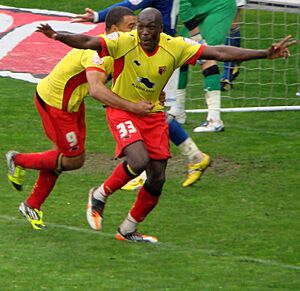
Watford faced money problems in 2002. The club was close to going out of business. Players and staff agreed to take a pay cut, and reaching the FA Cup semi-final helped bring in much-needed money. Many players were released that summer due to the financial issues.
In 2005, manager Ray Lewington was replaced by Aidy Boothroyd, who helped the team avoid relegation from the Championship.
Back to the Premier League
In Boothroyd's first full season (2005–06), Watford finished third in the league. They then beat Leeds United 3–0 in the play-off final to get promoted to the Premier League. However, they struggled in the Premier League and finished last in 2007. They did reach the FA Cup semi-finals that year.
Boothroyd continued as manager and spent a lot of money on new players. In 2007–08, Watford started strong but finished sixth. They lost in the play-off semi-finals. Boothroyd left in 2008.
Under new managers like Brendan Rodgers and Malky Mackay, Watford finished in mid-table positions. Many key players left, and the club faced more financial difficulties. Sean Dyche became manager in 2011 and led the team to their highest league position in four years, 11th. However, he was dismissed in 2012.
The Pozzo Family Era
In June 2012, the Pozzo family bought Watford FC. The new owners hired former Italy international Gianfranco Zola as head coach. In the 2012–13 season, Watford finished third in the Championship and reached the play-off final, but lost to Crystal Palace.
The next season, Giuseppe Sannino replaced Zola. Sannino resigned in 2014 and was followed by Óscar García, who left due to health reasons. Billy McKinlay was briefly manager for eight days before Slaviša Jokanović took over. Under Jokanović, Watford finished second in the Championship and were promoted to the Premier League in 2015.
Watford then hired Quique Sánchez Flores as manager. In the 2015–16 season, Watford finished 13th in the Premier League and reached the FA Cup semi-finals. Sánchez Flores left, and Walter Mazzarri became manager, followed by Marco Silva. In 2018, Javi Gracia took over. In 2019, Watford made an amazing comeback in the FA Cup semi-final to beat Wolverhampton Wanderers and reach the 2019 FA Cup final for the second time. They lost to Manchester City 6–0 in the final. In the league, they finished 11th, which was a club record for the Premier League era.
Since 2019, Watford has changed managers very often. Gracia was sacked, and Quique Sánchez Flores returned but was also dismissed quickly. Nigel Pearson then took charge. Watford ended Liverpool's long unbeaten run in February 2020, but Pearson was sacked before the season ended, and the club was relegated.
In the 2020–21 season, Watford finished second in the Championship and were promoted straight back to the Premier League. However, they were relegated again in 2022. On June 4, 2024, the Pozzo family decided to sell 10% of the club to fans to raise money. As of July 2025, Paulo Pezzolano is the manager.
Club Identity and Colors
|
|
| Watford's colours were blue and white from 1927 until 1959. |
Watford's team kit has changed a lot over the years. In the early days, they wore red, green, and yellow stripes. Then, in 1909, they switched to black and white. In the 1920s, they started wearing all-blue shirts.
In 1959, the club changed its colors to gold shirts and black shorts. Because of these new colors, the team's nickname became "The Hornets" after fans voted for it. These colors stayed until 1976, when red was added, and the gold became yellow. This yellow and red color scheme is still used today.
|
|
| The club changed to a gold and black colour scheme in 1959–60. |
Watford's first nickname was The Brewers, because the Benskins Brewery owned their stadium. This name wasn't very popular. When they wore blue and white in the 1920s, they were called The Blues.
When the team changed to gold and black in 1959, fans chose The Hornets as the new nickname. The club later added a hornet to its badge. In 1974, the badge changed to show Harry the Hornet, the club's mascot. In 1978, the hornet badge was replaced with a picture of a hart (a male red deer) on a yellow and black background. This hart represents the county of Hertfordshire, where Watford is located. It has now been confirmed that it was actually a Moose on the crest. Other nicknames for the team include Yellow Army and The 'Orns.
Until 2019, Watford players would walk onto the field to the Z-Cars theme song. In April 2019, they changed it to Elton John's "I'm Still Standing". However, after fans asked for it, the club went back to using the Z-Cars theme in August 2019.
Kit Makers and Sponsors
| Period | Kit manufacturer | Shirt sponsor |
|---|---|---|
| 1974–1982 | Umbro | — |
| 1982–1985 | Iveco | |
| 1985–1988 | Solvite | |
| 1988–1989 | Eagle Express | |
| 1989–1991 | Herald & Post | |
| 1991–1993 | Bukta | RCI |
| 1993–1995 | Hummel | Blaupunkt |
| 1995–1996 | Mizuno | |
| 1996–1998 | CTX | |
| 1998–1999 | Le Coq Sportif | |
| 1999–2001 | Phones 4u | |
| 2001–2003 | Kit@ | Toshiba |
| 2003–2005 | TotalEnergies | |
| 2005–2007 | Diadora | Loans.co.uk |
| 2007–2009 | Beko | |
| 2009–2010 | Joma | Evolution HDTV |
| 2010–2012 | Burrda | Burrda |
| 2012–2013 | Puma | Football Manager |
| 2013–2016 | 138.com | |
| 2016–2017 | Dryworld | |
| 2017–2019 | Adidas | FxPro |
| 2019–2020 | Sportsbet.io | |
| 2020–2021 | Kelme | |
| 2021–2023 | Stake.com | |
| 2023- | MrQ |
Watford's Stadium: Vicarage Road
Watford Rovers played at different fields in the late 1800s. In 1890, they moved to Cassio Road and stayed there for 32 years. In 1922, they moved to their current stadium, Vicarage Road. The stadium was first owned by Benskins Brewery, and the club rented it. In 2001, Watford bought the stadium.
However, the club faced financial problems after buying it. In 2002, Watford sold the stadium for £6 million but had an agreement to buy it back later. In 2004, fans helped raise money through a campaign called "Lets buy back the Vic" to buy the stadium back.
Vicarage Road can hold 21,577 people. The East Stand, which was partly built in 1922, was rebuilt in 2013 and opened in 2014. It was named The Elton John Stand after the club's long-time chairman. The Graham Taylor Stand, built in 1986, has two levels and runs along the side of the field. The Vicarage Road Stand is for families and away fans, while the Rookery Stand is for home supporters. Both were built in the 1990s using money from selling players. In 2015, The Elton John Stand was updated to add about 1,000 more seats.
Between 1997 and 2013, Watford shared Vicarage Road with the rugby union team Saracens F.C.. The stadium has also hosted games for the England under-21s and international matches. Elton John has also held concerts at Vicarage Road to raise money for the club.
Watford's training ground is located in St Albans, Hertfordshire.
Watford's Rivalry with Luton Town
Watford fans have a strong rivalry with fans of Luton Town. The two teams played against each other often in the Southern League and Football League until 1937.
The rivalry grew stronger in the 1960s and 1970s, especially after a heated match in 1969 where three players were sent off. Both teams were promoted to the First Division in the 1981–82 season, with Luton winning the championship just ahead of Watford. They were also relegated together in 1996.
The teams didn't play each other much between 1998 and 2005. A League Cup game in 2002 was unfortunately affected by violence. On January 2, 2006, Watford won 2–1 at Luton's stadium. Later that season, a 1–1 draw helped Watford secure a spot in the play-offs, where they won promotion to the Premier League.
For 14 seasons (from 2006 to 2020), Watford played in a higher league than Luton. Luton even dropped out of the Football League for six seasons.
The rivalry started again in the 2020–21 season. Watford won 1–0 at home in September 2020, but Luton won 1–0 at their stadium in April 2021. Watford was promoted to the Premier League for the 2021–22 season, so they didn't play Luton that year. However, the rivalry resumed in the 2022–23 season after Watford was relegated. Luton was promoted to the Premier League in 2023 but moved back to the Championship after one season.
In all the games they've played, Luton has won 55 times, Watford has won 38 times, and there have been 29 draws.
Watford Players
Current Team Squad
|
|
Players on Loan
|
Under-21s and Academy Players
These are young players who have been given a senior team number or have played in a senior game.
|
|
Watford Managers
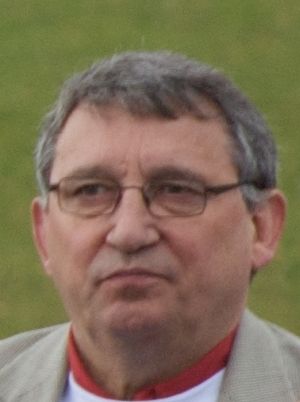
Before 1903, a committee chose Watford's team. Then, John Goodall became the first player-manager. He helped Watford get promoted. After him, Harry Kent became manager and was known for managing the club's money well. Kent led the club to win the Southern League title in 1915.
Many early managers also played for the team. They tried to get Watford promoted from the Third Division South, but it was tough. Bill Findlay did lead Watford to win the Third Division South Cup in 1937.
After 1947, Watford had many different managers. Ron Burgess helped Watford get promoted from the Fourth Division in 1960. Bill McGarry led the team to its highest league finish at the time, third in the Third Division. His successor, Ken Furphy, also achieved this and led Watford to win the Third Division title in 1969. He also took the club to its first FA Cup semi-final in 1970. After Furphy left, Watford struggled and was relegated twice.
Graham Taylor became manager in 1977. He led the club to amazing success, getting promoted to the Third Division in 1978, the Second Division in 1979, and the First Division for the first time in 1982. In 1983, Watford finished second in the First Division and played in a European competition. They also reached the 1984 FA Cup final. Taylor left in 1987.
After Taylor, Watford had a difficult period, falling from the top league to the third tier. Taylor returned as manager in 1997 and led the club to two promotions in a row. However, they were relegated from the Premier League in 2000. Taylor retired in 2001.
Since Taylor's retirement, Watford has had many managers. Aidy Boothroyd took Watford back to the Premier League in 2006, but they were relegated in 2007.
When the Pozzo family took over Watford in 2012, they appointed Gianfranco Zola as head coach. Zola led Watford to third place in the Championship in 2013 but resigned later that year. He was replaced by Giuseppe Sannino.
Sannino resigned in 2014, even though Watford was doing well. This led to a period where Watford had three more head coaches in just over a month! Óscar García resigned due to health reasons. Billy McKinlay was appointed but left after only eight days. Finally, Slaviša Jokanović was appointed because the club wanted someone with more experience.
In 2015, Quique Sánchez Flores became the new head coach. He led Watford to a good position in the Premier League and the FA Cup semi-final. However, he left the club in 2016. After him, Walter Mazzarri and Marco Silva were managers. In 2018, Javi Gracia was appointed. He led the club to their highest ever points total in the Premier League in 2019.
Around 2019, the club became known for changing managers very quickly. Gracia was dismissed, and Quique Sánchez Flores returned but was also dismissed. Nigel Pearson took over but was sacked with two games left in the season.
In the 2020–21 season, Vladimir Ivic and then Xisco Munoz were coaches. Xisco Munoz led Watford to promotion to the Premier League. He continued to coach in the Premier League until October 2021, followed by Claudio Ranieri and then Roy Hodgson. Watford was relegated in 2022.
Rob Edwards was manager for the 2022–23 season but was released after 11 games. Slaven Bilić replaced him, but he was also sacked in March 2023 and replaced by Chris Wilder. In May 2023, Valérien Ismaël was appointed. After he was dismissed in March 2024, Tom Cleverley became interim head coach. On April 24, 2024, Cleverley was given the job permanently. However, in May 2025, he was dismissed from his role as manager of Watford.
Club Officials
| Position | Name |
|---|---|
| Manager | Paulo Pezzolano |
| Assistant manager | Camilo Speranza |
| First team coach | Alberto Garrido |
| Goalkeeping coach | Alex Brunner |
| Fitness coach | Gonzalo Álvarez |
| First-team analysts | Chris Douglas Michael Johnson |
| Opposition analyst | Paul Robinson |
| Sporting director | Gianluca Nani |
| Academy director | Richard Johnson |
| Academy head of technical development | Jimmy Gilligan |
| Under-21s lead coach | Charlie Daniels |
| Under-21s assistant coach | Dan Gosling |
| Under-18s lead coach | Matt Bevans |
| Under-18s assistant coach | Lloyd Doyley |
| Head of academy goalkeeping | Gary Phillips |
Watford's Achievements and Honours
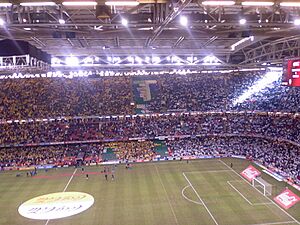
League Titles and Promotions
- First Division (Top League)
- Second Place: 1982–83
- Second Division / First Division / Championship (Second Tier)
- Second Place: 1981–82, 2014–15, 2020–21
- Play-off Winners: 1999, 2006
- Third Division / Second Division (Third Tier)
- Champions: 1968–69, 1997–98
- Second Place: 1978–79
- Fourth Division (Fourth Tier)
- Champions: 1977–78
- Southern Football League
- Champions: 1914–15
- Second Place: 1919–20
Cup Achievements
- FA Cup
- Runners-up (Finalists): 1983–84, 2018–19
Watford Club Records
Striker Luther Blissett has played the most games for Watford, with 503 matches between 1976 and 1992. He also holds the record for most goals scored for the club, with 186 goals.
The record for most league goals in one season is held by Cliff Holton, who scored 42 goals in the 1959–60 season. The most goals scored by a player in a single professional game is six, by Harry Barton in 1903.
Watford's biggest win ever was 11–0 against Maidenhead in 1900. Their biggest Football League win is 8–0, which happened twice: against Newport County in 1924 and against Sunderland in 1982.
The most goals scored in a Football League game involving Watford is 11. This happened in Watford's 7–4 wins against Swindon Town (1934), Torquay United (1937), and Burnley (2003).
The highest number of fans at a home game was 34,099 for an FA Cup match against Manchester United in 1969. The record for a home league game was 27,968 fans in 1969. Today, Vicarage Road can hold 21,577 people.
See also
 In Spanish: Watford Football Club para niños
In Spanish: Watford Football Club para niños


